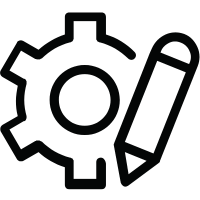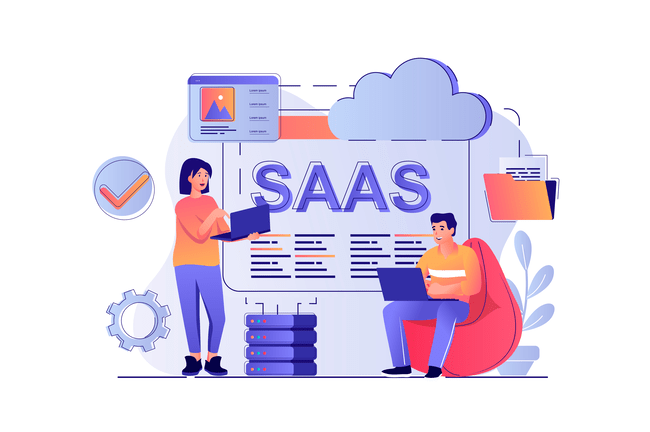“Should I go for a single tenant SaaS and customize my enterprise SaaS exactly the way I want?” or “Should I go for a multi-tenant SaaS architecture to scale my business for a massive customer base?”. Finding yourself stuck at the same crossroad soon after commencing your SaaS development journey? Don’t worry, you’re not alone and by the end of this blog, you will have all the necessary insights to make a logical & data-backed choice!
According to GlobeNewswire, the SaaS market was worth around $167.53 Billion in 2022, and it is expected to reach around $462.94 Billion by 2028 at a promising 18.5% CAGR. The numbers shouldn’t be a surprise considering the fact that a single mid-sized business can use anywhere between a few dozen to well over a hundred SaaS applications by itself. Furthermore, each of these SaaS applications contributes towards alleviating different business pain points.
Picking the right architecture before the SaaS development phase has a monumental impact on the functionality and scalability of the application. To get a better idea for the question: “Which architecture is better for my business?”, we can explore various architectural formats available in the market. Let’s start by evaluating the ABCs of single-tenant SaaS & multi-tenant SaaS architectures, two of the most popularly used architectures for the development of enterprise applications.
Single Tenant SaaS Architecture – A General Outline
Exactly as the name suggests, a single-tenant SaaS architecture provides every single user with a unique instance of the software along with a dedicated server. With dedicated servers, users benefit from optimal performance, security, and flexibility, as the server’s resources are exclusively allocated to a single tenant. Thus, these users/tenants have absolute control over the software and they can customize it according to their personal preferences & unique business needs.
You can think of it as renting an apartment for yourself in a housing complex. You get access to the entire apartment and have the authority to make any changes you deem necessary within the allotted space. However, as you are the only person using the application instance, it is your responsibility to pay for the expenses of using the space.
So far we got a high-level idea of the pros and cons involved with using a single-tenant architecture. Let’s discuss them in depth in the following sections:
Benefits of Using a Single Tenant SaaS Architecture
Choosing to settle for a single-tenant architecture can assist your business and users alike, here’s how:

(1) Control Over Operations and Customizability
The application developed for a single-tenant environment comes bundled with a wide range of controllability enhancement features. You can use these features to customize the workflow of the SaaS applications and align it with your business goals. Single-tenant software allows you to brand your software instance to match the theme of your organization, this is very important for a business that wants to stand out from the competitors and develop its own identity.
Additionally, you have the option to integrate your SaaS software into your pre-existing CRM & ERP systems, or even a third-party software without any hiccups. This helps your business to streamline workflow, increase productivity, enhance customer experience, and much more.

(2) Enhanced Security
In a single-tenant SaaS application, each instance of the software is completely isolated from a similar software instance with absolutely zero point of contact, and each user is allocated a personal server to proceed with their business operations. So, even if one of your neighboring tenants was attacked by an unwanted foreign agent, your application and business data will be completely safe.

(3) Easy Backup and Restoration
In a single-tenant architecture, the system assigns you a personal space within the cloud for the storage & backup of your business data. You can schedule the frequency of this backup either to an interval-based backup system or a real-time continuous backup model to make sure your cloud is updated as frequently as possible. This is crucial in situations where your business data gets corrupted due to an unknown reason, you can use the data stored in the cloud as a backup point to restore the application to the latest non-corrupted version without losing any major information.

(4) Reliability
Every single-tenant architecture provides its clients with a personal environment to operate. This means that the application instance is isolated from any operational disruptions or security breaches that happen elsewhere, making the performance of the entire architecture much more reliable.
Want the Opinion of SaaS Experts?
The Drawbacks of Using a Single Tenant SaaS
Every coin has two sides. Let’s discuss the challenges that tag along with the implementation of using this architecture:

[1] Expensive to Own
Personalized servers, customizability options, and enhanced security come at a price. Businesses, especially the small to mid-scale ones may struggle to afford a single-tenant application. This means they either compromise on the features by using only a handful of them or they have to completely scrap the idea of choosing this format.

[2] Maintenance is Complicated
More features mean more complexity, leading to more issues. Depending on the terms of the agreement signed, the tenant can be liable for fixing a number of these issues themselves, which may lead to frequent disruptions in the workflow. In certain scenarios, you will be responsible for the maintenance of the entire application, which means you have to hire a team of experts for the job, further stacking up your expenses.

[3] May Have to Struggle in Certain Scenarios
The enhancement options of a single-tenant SaaS application come mostly as a gift but they can often take the form of a curse as well. If not handled properly, the combination of the increased complexity of the application due to these enhancements and the isolated nature of a single-tenant architecture makes it difficult to integrate this application with other services. It also limits the scalability of the application as the service provider has to assign you a separate server every time you wish to scale your business.
Multi-Tenant SaaS Architecture – The Definition
If we compare it to the previously mentioned architecture, the primary change that you will notice right off the bat is the number of tenants using a single instance of the software. Let’s get back to the apartment example to get a better grasp of how multi-tenant architecture is different.
Imagine you chose to share your previously rented apartment with a few additional tenants. With new individuals using the apartment space is now divided into private and common sections, which means you do not have access to the entire apartment anymore. However, as multiple individuals use the same apartment, the management cost & rent are significantly lower for you compared to the single-tenant SaaS architecture.
Benefits of using a Multi-Tenant SaaS Architecture
Let’s scan down the core benefits of opting for a multi-tenant application and how it can have a positive impact on your business operations:

(a) Reduced Costs
Since you are sharing the server with other tenants the subscription cost of the service is significantly lower compared to the previously mentioned architecture. This particularly benefits small-scale businesses as they can capitalize on the enhancements that SaaS applications provide without decimating their entire budget.
.png)
(b) Scalability
The multi-tenant application is pretty much similar for every user, and multiple users can share a single instance of the software. This makes it easier for businesses to scale the model as a new customer can subscribe to the services anytime to get identical benefits to someone who has been using the services for a long time now. Additionally, it is super easy for service providers to add and remove tenants depending on the contract norms, unlike single-tenant SaaS applications.
.png)
(c) Reduced Maintenance Responsibility
The multi-tenant application is pretty much similar for every user, and multiple users can share a single instance of the software. This makes it easier for businesses to scale the model as a new customer can subscribe to the services anytime to get identical benefits to someone who has been using the services for a long time now. Additionally, it is super easy for service providers to add and remove tenants depending on the contract norms, unlike single-tenant SaaS applications.

(d) Improved Efficiency
Since you use your application instance simultaneously with other tenants, the resource available in your environment is used to its absolute potential. Additionally, as multiple users share a common space for operating the application, the instance is typically designed to handle high-capacity operations to avoid technical failures.
The Issues with Using a Multi-Tenant SaaS
Implementing a multi-tenant SaaS application is typically considered to be a better choice for businesses that are just starting with their application journey. However, there are a few factors that you should consider before making any conclusive decisions:

1. Increased Downtime
Just like a noisy neighbor disrupts your living conditions in real life, sharing the server with a noisy tenant can disrupt your workflow and make your business less reliable. How? In case your neighboring tenant had a sudden traffic surge on their server, the tenant will “borrow” a majority of the resources from the server for themselves. Making the entire application instance slow and unresponsive, which sometimes leads to server failure. So, even though it was not your fault you may have to face additional downtime because of someone else.

2. Limited Customizability
The users of a multi-tenant SaaS architecture often complain about the limited customization options available. Having multiple users in the same instance restricts the vendors from giving a single user with full access to customize the application as it can oppose the preferences of other users on the same server. This is why most multi-tenant SaaS applications that you come across have a very generic design that serves the preferences of a broader domain of users.

3. Security Issues
Your business shares the database with other users in a multi-tenant application which means that your business data is not completely isolated. Now, in case one of your neighbors was exposed to a cyber attack, the entire data on the server (including your business data) will be vulnerable.
Single Tenant Vs Multi-Tenant SaaS – Which Suits Your Business Better?
We have covered the pros and cons associated with the development of a SaaS application with a single-tenant architecture and a multi-tenant architecture. However, it is a possibility that you are still struggling to decide which of the two is a superior choice for your specific business model. Let’s fix your confusion in this section by comparing both architectures based on some important parameters:

[a] Size of Your Business
- Single Tenant SaaS: If your business is operating at an enterprise level with complicated customization needs, a single-tenant SaaS application should be your preferred architecture.
- Multi Tenant SaaS: In the case of a small to midsize business that is looking for a rather simple application with standard operational features, a multi-tenant SaaS should be the more obvious choice.
.png)
[b] Expected Scalability
- Single Tenant SaaS: It is preferred to go for a single tenant architecture when the footfall on your application is predictable and you can pre-plan to scale your business based on the workload changes.
- Multi Tenant SaaS: Recommended for businesses with a fluctuating user base as it is easier to scale up and scale down as per the workload changes.

[c] Budget for the Project
- Single Tenant SaaS: The specifications of a single tenant architecture include a dedicated infrastructure along with multiple customizable features and high-security standards. This makes the overall cost of development inclined towards the expensive end of the meter.
- Multi Tenant SaaS: Since you share your infrastructure with other tenants and operate with standard features without actually owning any piece of infrastructure, the budget for operating within this architecture is relatively lower.

[d] Customization Requirements
- Single Tenant SaaS: As you have an isolated environment with full control over the assigned cloud space, the scope for customization is very high.
- Multi Tenant SaaS: Sharing the environment with other tenants limits the flexibility of your SaaS application, limiting the scope for customization.

[e] Security and Compliance
- Single Tenant SaaS: If your business model demands high-security standards, single-tenant architecture can be a perfect match due to its isolated working environment. Industry-specific protocol compliance is also supported.
- Multi Tenant SaaS: Multi-tenant SaaS does not provide you with an isolated working space, however, it still has standard security & compliance measures, although they are not as reliable as the previously mentioned architecture.
More Existing Architectures that Can be Better for Your Business Niche
In case you feel like single and multi-tenant architectures are not the perfect fit for your business, you might wanna check out some additional SaaS architectures our developers excel at:

[a] Hybrid SaaS Architecture
If you are looking for a SaaS application that has minimal latency, then the cloud-based services we discussed so far won’t be the best choice for you. In this situation, a hybrid architecture can be a better choice for your business as you can combine an on-premise architecture with a cloud-based architecture.
For example, consider you have a retail business with a busy storefront, and you want a system that can update your inventory data quickly. However, if the data is stored in the cloud the latency levels are high which affects your workflow efficiency. In this scenario, you can install an on-premise solution to process the inventory data in real time with minimal latency. However, you’re still gonna need the cloud-based services for tasks like user authentication, making the hybrid architecture an ideal choice in this situation.

[b] SaaS Microservices
Let’s say your business model needs multiple independent components to deal with separate business sectors. So naturally, instead of investing in a monolithic architecture designed to cater to a single aspect of the business you’d want a solution that can cover multiple use cases. In this situation, cloud-based SaaS microservices will be the perfect match for your business.
Consider a medical establishment that automates the services such as patient registration, medical record extraction, and automated payment settlement. As all of these services belong to separate aspects of the business, developing a dedicated SaaS application for each service will be pretty expensive & complicated. Alternatively, the implementation of microservices for these operations can make the process much more efficient.

[c] Serverless SaaS
Some businesses want to avoid the hassle of managing a server so they let the cloud service providers manage it for them. Using serverless architecture helps businesses to spend less time on maintenance and more time working towards their business goals. However, it’s not all a fairy tale, operating on a serverless architecture limits the complexity of the model. This means your business might have to use multiple application instances which may add to the complexity of the entire SaaS solution.
What Makes BinaryFolks Your Go-To SaaS Partner?
Congratulations! You know your SaaS architectures now! But we’re not done just yet. Since you chose us to be your source of information on this topic, how about we take this a step further and showcase the services we have to offer for these architectures?
(1) Hands-on Experience with Developing Multiple Architectures
Our SaaS developers have hands-on experience with developing SaaS applications across multiple architectures. No matter which architecture suits your taste, it is very likely that we already have satisfied customers who chose the same architecture. We’ll be happy to add you to the list!
(2) Professional Suggestions Based on Your Unique Business Model
Having second thoughts about the architecture you wanna go with? Don’t fret, our SaaS consultants would be happy to assist you. You can ping us anytime and we will set up a meeting to discuss your requirements. You provide us with the details and we will provide you with our expertise. And you know the best part? Our consultancy costs exactly $0, pretty cool, right? Let’s get started!
We covered all there is to know about the various architectures of a SaaS application, from the yays and nays of both single and multi-tenant SaaS applications to the other alternatives available. However, if you’re having a hard time determining the positioning of your business in the SaaS market, we have a few ideas for you!
- Chalk down your high-level requirements from the SaaS application and shoot it our way, and we will help you figure out what architecture best fits your business needs! With our extensive experience in the industry, we are confident that we will have the recommendations you need!
- Alternatively, if writing down the requirements seems to be a hassle, how about we discuss it over a Zoom call? Not sponsored BTW! (‘:
Get Complimentary SaaS Consultation





.png)
